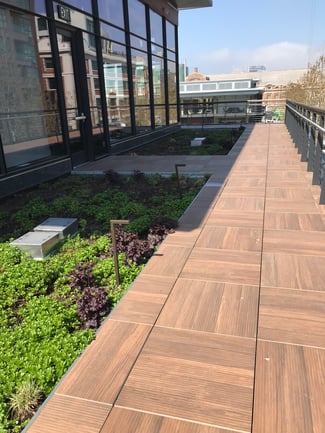How to Properly Install Archatrak Deck Tiles and Maintain Low-Maintenance Decking Over Time
When it comes to selecting a material for your rooftop deck, terrace, patio, balcony, or outdoor floor, homeowners today have an almost overwhelming list of options. With so many choices at your disposal, every differentiating factor matters, and that includes installation and maintenance considerations. Read on to learn key pointers about the Archatrak installation process, as well as maintenance tips for keeping the product looking pristine.
6 Archatrak Installation Considerations
-
Obtain a wet tile saw.
In the installation process, you’ll have to cut a number of Archatrak tiles to fit your space, whether that’s an elevated deck or a patio. To precisely and safely cut these tiles, you’ll need a wet tile saw. The equipment doesn’t have to be top of the line or professional grade, but you will need to ensure you’re using the correct blade, which is one that’s appropriate for porcelain or ceramics. The saw can either be rented or purchased, depending on relative price points and your likelihood of needing the equipment in the future.
-
Ensure containment on all four sides.
When building out your Archatrak structure, make sure you’ve accounted for containment on all four sides of the project. If you’re building a deck, for example, one side will be contained by the building itself, and two other sides will likely have walls or something similar for support. That still leaves the far side unaccounted for, though. Even though the pedestals and pavers don’t shift or slide easily, it’s still recommended not to have them simply stop in open space. This sometimes requires custom perimeter work (either in wood or metal) to ensure that final row of pavers has something solid to butt up against. Depending on your comfort level with home improvement, it might be best to enlist a professional for this portion of the project.
-
Select the correct pedestal type.
Archatrak has two main pedestal types. One self-levels by swiveling up to 5 percent in all directions. This accommodates for upwards of a 5 percent slope. If you’re working with anything over a one-quarter-inch linear slope, professional installers recommend opting for the self-leveling option.
The fixed pedestals (not self-leveling) are cheaper, however, and 1 percent sloping shims are available. You can stack up to three of these shims per pedestal head to accommodate for your slope. Note, if your slope is more severe than 3 percent and you still opt for fixed pedestals, your pavers might not end up sitting flush, and you can get unwanted vertical movement.
-
Think through the layout before you start your Archatrak project.
Some homeowners are so excited to start their Archatrak projects that they dive in immediately and start assembling the pedestals and pavers. More often than not, though, this leads to running out of pedestals that are the correct height for the space. Before you start, professional installers recommend laying out the full project first to ensure you know which pedestals are meant to go where. This little bit of advance planning can save you a lot of time in the long run.
-
Account for the weight and size of the Archatrak delivery.
Even though Archatrak is less bulky and heavy than other decking materials, such as concrete, the delivery is still likely going to be substantial. If you live on the tenth floor of your building, for example, make sure you’ve thought about, discussed, and arranged for all logistical hurdles. Will you rent a boom truck? Do you have a crew to get the material to the elevator? Will you need a pallet jack? Have you coordinated the day and time of delivery to ensure you’ll be there to deal with it? The size and weight of your delivery depends, of course, on the scope of your project, but just make sure you’ve adequately made plans for your delivery.
-
Assess if a do-it-yourself installation is possible.
Lots of homeowners balk at the idea of a DIY installation of this kind, but it’s entirely possible. Archatrak routinely gets photos and comments from homeowners saying how easy, quick, and seamless the installation process was. Part of what makes the system painless is that you can make small adjustments to the pedestal system simply by twisting left and right where four pedestals and pavers come together. Without having to pull everything apart, these adjustments can be made after that initial install.
That being said, you do have to assess the size and complexity of your Archatrak project. Larger projects are more likely to need custom work, such as working around a drain, boxing in obstructions, dealing with an awkward amount of space left for the final row, and so on. On larger decks, it might be necessary to lean on professionals, but it’s worth having the conversation to determine if a DIY install is feasible or not.
Whether it’s contractors or individuals doing the install, people do often find the work easier and quicker than anticipated. Contractors who are used to deck projects taking a week routinely find Archatrak projects take only a few days.
3 Archatrak Maintenance Considerations
-
Archatrak pavers are nonporous.
From a maintenance perspective, the biggest differentiating factor between Archatrak and other decking or paving material is that Archatrak is nonporous. Unlike concrete, where grease, wine, water, and anything else can seep into the material, Archatrak is impermeable to all these things. This means maintenance is largely comprised of simply hosing the material off when necessary, and because you don’t have to worry about water getting into the material, mold and mildew aren’t concerns either.
-
How to deal with tougher stains, such as rust.
If you leave something like a metal planter box or metal deck chair on an Archatrak surface, it’s possible to get rusty pooling water. If these kinds of stains don’t immediately hose off with water alone, opt for a light soapy solution and a bristly brush. These common household tools should be enough to remove the surface stain.
-
Annual maintenance requirements.
Perhaps one of the biggest advantages to the Archatrak material is that it never has to be sealed, painted, or stained. While other decking material requires costly and time-intensive annual maintenance, Archatrak will hold up to outdoor conditions straight out of the packaging.
While factors like price and overall product appearance are always going to be influential in the buying decision, picking out material for your deck, terrace, or patio should also take into account installation and maintenance considerations. After all, straightforward installation and minimal (to nonexistent) maintenance requirements can end up saving you a huge amount of time and money over the life of the product!



